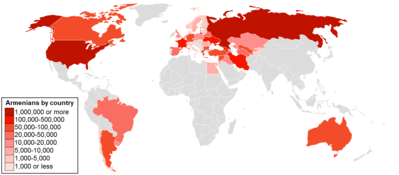Armenian diaspora
The Armenian diaspora refers to the communities of Armenians outside Armenia and other locations where Armenians are considered an indigenous population. Since antiquity, Armenians have established communities in many regions throughout the world. However, the modern Armenian diaspora was largely formed as a result of WWI, when the Armenian Genocide ordered by the Ottoman Empire forced the people living in their homeland to flee or be killed.[1]
.svg.png)
| Part of a series on |
| Armenians |
|---|
 |
| Armenian culture |
|
Architecture · Art Cuisine · Dance · Dress Literature · Music · History |
| By country or region |
|
Armenia · Artsakh See also Nagorno-Karabakh Armenian diaspora Russia · France · India United States · Iran · Georgia Azerbaijan · Argentina · Brazil Lebanon · Syria · Ukraine Poland · Canada · Australia Turkey · Greece · Cyprus Egypt · Singapore · Bangladesh |
| Subgroups |
| Hamshenis · Cherkesogai · Armeno-Tats · Lom people · Hayhurum |
| Religion |
|
Armenian Apostolic · Armenian Catholic Evangelical · Brotherhood · |
| Languages and dialects |
| Armenian: Eastern · Western |
| Persecution |
|
Genocide · Hamidian massacres Adana massacre · Anti-Armenianism Hidden Armenians |
Terminology
In Armenian, the diaspora is referred to as spyurk (pronounced [spʰʏrkʰ]), spelled սփիւռք in classical orthography and սփյուռք in reformed orthography.[2][3] In the past, the word gaghut (գաղութ pronounced [ɡɑˈʁutʰ]) was used mostly to refer to the Armenian communities outside the Armenian homeland. It is borrowed from the Aramaic (Classical Syriac) cognate[4] of Hebrew galut (גלות).[5][6]
History
The Armenian diaspora has been present for over 1,700 years.[7] The modern Armenian diaspora was formed largely after World War I as a result of the Armenian Genocide. According to Randall Hansen, "Both in the past and today, the Armenian communities around the world have developed in significantly different ways within the constraints and opportunities found in varied host cultures and countries."[1]
In the fourth century, Armenian communities already existed outside of Greater Armenia. Diasporic Armenian communities emerged in the Sassanid and Persian empires, and also to defend the eastern and northern borders of the Byzantine Empire.[8] In order to populate the less populated areas of Byzantium, Armenians were relocated to those regions. Some Armenians converted to Greek Orthodoxy while retaining Armenian as their language, whereas others remained in the Armenian Church despite pressure from official authorities. A growing number of Armenians voluntarily migrated or were compelled to move to Cilicia during the course of the eleventh and twelfth centuries. After the fall of the kingdom to the Mamelukes and loss of Armenian statehood in 1375, up to 150,000 went to Cyprus, the Balkans, and Italy.[8] Although an Armenian diaspora existed during Antiquity and the Middle Ages, it grew in size due to emigration from the Ottoman Empire, Iran, Russia, and the Caucasus.
The Armenian diaspora is divided into two communities – those from Ottoman Armenia (or Western Armenian) and those who are from the former Soviet Union, the independent Armenia and Iran. (or Eastern Armenian)
Armenians of the modern Republic of Turkey do not consider themselves as part of the Armenian Diaspora, since they believe that they continue residing in their historical homeland.
The Armenian diaspora grew considerably during and after the First World War due to dissolution of the Ottoman Empire.[9] Although many Armenians perished during the Armenian Genocide, some of the Armenians managed to escape, and established themselves in various parts of the world.
Distribution
Today, the Armenian diaspora refers to communities of Armenians living outside of Armenia. The total Armenian population living worldwide is estimated to be 11,000,000.
Of those, approximately 3 million live in Armenia, 130,000 in the de facto independent Nagorno-Karabakh and 120,000 in the region of Javakhk in neighboring Georgia. This leaves approximately 7,000,000 in diaspora (with the largest populations in Russia, the United States, France, Argentina, Lebanon, Syria, Iran, Turkey, Canada, Ukraine, Greece, and Australia).[10]
Less than one third of the world's Armenian population lives in Armenia. Their pre-World War I population area was six times larger than that of present-day Armenia, including the eastern regions of Turkey, northern part of Iran, and the southern part of Georgia.[11]
Population by country
See also
References
- Hansen, Randall. Immigration and asylum: from 1900 to the present. p. 13.
- Dufoix, Stéphane (2008). Diasporas. Berkeley, California: University of California Press. p. 84. ISBN 978-0-520-25359-9.
- Harutyunyan, Arus (2009). Contesting National Identities in an Ethnically Homogeneous State: The Case of Armenian Democratization. Western Michigan University. p. 56. ISBN 978-1-109-12012-7.
- Ačaṙean, Hračʿeay (1971–1979). Hayerēn Armatakan Baṙaran [Dictionary of Armenian Root Words]. 1. Yerevan: Yerevan University Press. p. 505.
- Melvin Ember; Carol R. Ember; Ian A. Skoggard (2004). Encyclopedia of diasporas: immigrant and refugee cultures around the world. Dordrecht, Netherlands: Kluwer Academic Publishers. p. 37. ISBN 978-0-306-48321-9.
- Diaspora: Volume 1, Issue 1. Oxford University Press. 1991. ISBN 978-0-19-507081-1.
- Herzig, Edmund (2004-12-10). The Armenians: Past And Present In The Making Of National Identity. p. 126. ISBN 9780203004937.
- Ember, Melvin; Ember, Carol R.; Skoggard, Ian (2004). Encyclopedia of Diasporas: Immigrant and Refugee Cultures around the World. Springer. pp. 36–43. ISBN 0-306-48321-1.
- Harutyunyan, Arus. Contesting National Identities in an Ethnically Homogeneous State: The Case of Armenian Democratization. Western Michigan University. p. 192. ISBN 9781109120127.
- "Armenia seeks to boost population". BBC News. 2007-02-21. Archived from the original on 3 September 2008. Retrieved 2008-09-05.
- Melvin Ember; Carol R. Ember; Ian A. Skoggard (2004). Encyclopedia of diasporas: immigrant and refugee cultures around the world. Dordrecht, Netherlands: Kluwer Academic Publishers. p. 36. ISBN 978-0-306-48321-9.
Currently, only one-sixth of that land [ancestral territory] is inhabited by Armenians, due first to variously coerced emigrations and finally to the genocide of the Armenian inhabitants of the Ottoman Turkish Empire in 1915.
- Bibliography
- Ayvazyan, Hovhannes (2003). Հայ Սփյուռք հանրագիտարան [Encyclopedia of Armenian Diaspora] (in Armenian). 1. Yerevan: Armenian Encyclopedia publishing. ISBN 5-89700-020-4.CS1 maint: ref=harv (link)
- de Waal, Thomas (2003). Black Garden: Armenia and Azerbaijan Through Peace and War. New York: New York University Press. ISBN 978-0-8147-1945-9.CS1 maint: ref=harv (link)
External links
| Wikimedia Commons has media related to Armenian diaspora. |
- Ovenk.com
- Armenian Ministry of Diaspora official website
- Hayern Aysor (Armenians Today) Official site of the Armenian Ministry of the Diaspora
- ArmDiasporaMuseum.com
- The Armenian Diaspora Today: Anthropological Perspectives. Articles in the Caucasus Anallytical Digest No. 29

